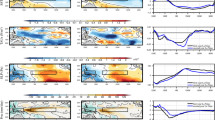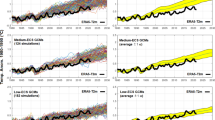Abstract
The atmospheric response to the evolution of the global sea surface temperatures from 1979 to 1992 is studied using the Max-Planck-Institut 19 level atmospheric general circulation model, ECHAM3 at T 42 resolution. Five separate 14-year integrations are performed and results are presented for each individual realization and for the ensemble-averaged response. The results are compared to a 30-year control integration using a climate monthly mean state of the sea surface temperatures and to analysis data. It is found that the ECHAM3 model, by and large, does reproduce the observed response pattern to El Nino and La Niña. During the El Nino events, the subtropical jet streams in both hemispheres are intensified and displaced equatorward, and there is a tendency towards weak upper easterlies over the equator. The Southern Oscillation is a very stable feature of the integrations and is accurately reproduced in all experiments. The inter-annual variability at middle- and high-latitudes, on the other hand, is strongly dominated by chaotic dynamics, and the tropical SST forcing only modulates the atmospheric circulation. The potential predictability of the model is investigated for six different regions. Signal to noise ratio is large in most parts of the tropical belt, of medium strength in the western hemisphere and generally small over the European area. The ENSO signal is most pronounced during the boreal spring. A particularly strong signal in the precipitation field in the extratropics during spring can be found over the southern United States. Western Canada is normally warmer during the warm ENSO phase, while northern Europe is warmer than normal during the ENSO cold phase. The reason is advection of warm air due to a more intense Pacific low than normal during the warm ENSO phase and a more intense Icelandic low than normal during the cold ENSO phase, respectively.
Similar content being viewed by others
References
Arpe K, Bengtsson L, Dümenil L, Roeckner E (1994a) The hydrological cycle in the ECHAM3 simulations of the atmospheric circulation. In: Debois M, Desalmand F (eds) Global Precipitation and Climate Change. NATO ASI Series Vol I 26:361–377
Arpe K, Bengtsson L, Dümenil L, Giorgetta M (1994b) Variability of the Indian monsoon in the ECHAM3 model, Part II: sensitivity to sea surface temperatures of the northern Indian ocean, soil moisture over Eurasia and the stratospheric QBO. Conf Monsoon Variability, Trieste May 1994, WCRP-Rep 84, WMO/TD-No. 619:621–628
Asselin R (1972) Frequency filter for time integrations. Mon Weather Rev 100:487–490
Barnett TP, Bengtsson L, Arpe K, Flügel M, Graham N, Latif M, Ritchie J, Roeckner E, Schlese U, Schulzweida U, Tyree M (1994) Forecasting global ENSO-related climate anomalies. Tellus 46A:381–397
Bengtsson L., Schlese U, Roeckner E, Latif M, Barnett TP, Graham N (1993) A two-tiered approach to long-range climate forecasting. Science 261:1026–1029
Bengtsson L, Botzet M, Esch M (1994a) Hurricane-type vortices in a general circulation model. Tellus 47A:175–196
Bengtsson L (1994b) Wie gut können wir das Klima mit einem numerischen Modell der allgemeinen Zirkulation simulieren? Symp Observation und Simulation der Atmosphäre, Potsdam, 6–7 May 1993. Ann Meteorol 29:93–132
Berlage HP (1966) The Southern Oscillation and world weather. K Ned Meteorol Inst Meded Verb 88:1–152
Bjerknes J (1962) Synoptic survey of the interaction of sea and atmosphere in the North Atlantic. Geofys Publ 24:115–145
Brankovic C, Palmer TN, Ferranti L (1994) Predictability of seasonal atmospheric variations. J Clim 7:217–237
Brinkop S (1991) Inclusion of cloud processes in the ECHAM PBL parameterization. In: R Sausen (ed) Studying climate with the ECHAM atmospheric model. Large-scale atmospheric modelling, Rep 9, 5–14, Meteorologisches Institut, Universität Hamburg, Germany
Brinkop S (1992) Parameterisierung von Grenzschichtwolken für Zirkulationsmodelle. Berichte aus dem Zentrum für Meeresund Klimaforschung, Reihe A. Meteorologie, Nr. 2, Meteorologisches Institut der Universität Hamburg, 77 pp
Cane MA (1992) Tropical Pacific ENSO models: ENSO as a mode of the coupled system. In: Trenberth K (ed), Climate system modeling, pp 583–614
Cubasch U (1985) The mean response of the ECMWF global model to the El Nino anomaly in extended range prediction. Atmos-Ocean 23:43–66
Delecluse P, Servain J, Levy C, Arpe K, Bengtsson L (1994) On the connection between the 1984 Atlantic warm event and the 1982–1983 ENSO. Tellus 46A:448–464
Doberitz R (1968) Cross-spectrum analyses of rainfall and sea temperature at the equatorial Pacific Ocean. Bonn Meteorol Abh 8:1–61
Dümenil L, Todini E (1992) A rainfall-runoff scheme for use in the Hamburg GCM. In: O'Kane JP (ed) Advances in Theoretical Hydrology. European Geophysical Society Series on Hydrological Sciences, 1, Elsevier, pp 129–157
Dümenil L, Arpe K, Bengtsson L (1994) Variability of the Indian Monsoon in the ECHAM3 model. Part I: MONEG and AMIP experiments. Conf Monsoon Variability, Trieste, May 1994, WCRP-Rep 84, WMO/TD-No. 619:609–620
Fraedrich K, Müller K (1992) Climate anomalies in Europe associated with ENSO extremes. Int J Clim 12:25–31
Gates WL (1992) AMIP the atmospheric model intercomparison project. Bull Am Meteorol Soc 73 (12):1962–1970
Glantz MH, Katz RW, Nicholls N (eds) (1991) Teleconnections linking worldwide climate anomalies. Cambridge University Press, Cambridge, UK
Graham NE, Ponater M, Barnett TP, Wilde R, Schubert S (1994) On the roles of tropical and mid-latitude SSTs in forcing interannual to interdecadal variability in the winter Northern Hemisphere circulation. J Clim 7:1416–1441
Hense A, Kerschgens M, Raschke E (1982) An economical method for computing radiative transfer in circulation models. Q J R Meteorol Soc 108:231–252
Hildebrandsson HH (1897) Quelque recherches sur les centres d'action de l'atmosphere. K Sven Vetenskaps Akad Handl 29:1–33
Hoerling M, Blackmon M, Ting M (1992) Simulating the atmospheric response to the 1985–87 El Niño cycle. J Clim 5:669–682
Ichiye T, Petersen J (1963) The anomalous rainfall of the 1957–58 winter in the equatorial central Pacific arid area. J Meteorol Soc Japan 41:172–182
Janowiak JE, Arkin PA (1991) Rainfall variations in the tropics during 1986–1989, as estimated from observations of cloudtop temperature. J Geophys Res 96:3359–3373
Kang IS, Lau NC (1987) Principal modes of atmospheric variability in model atmospheres with and without sea surface temperature forcing in the tropical Pacific. J Atmos Sci 43:2719–2735
Kushnir Y (1993) Interdecadal variations in North Atlantic sea surface temperature and associated atmospheric conditions. J Clim 7:141–157
Lau NC (1985) Modeling the seasonal dependence of atmospheric responses to observed El Niños 1962–1976. Mon Weather Rev 113:1970–1996
Lau NC, Nath MJ (1994) A modelling study of the relative roles of tropical and extratropical SST anomalies in the variability of the global atmosphere-ocean system. J Clim 7:1184–1207
Laursen L, Eliasen E (1989) On the effects of damping mechanisms in an atmospheric general circulation model. Tellus 41A: 385–400
Louis JF (1979) A parametric model of vertical eddy fluxes in the atmosphere. Boundary-Layer Meteorol 17:187–202
May W, Bengtsson L (1994) On the intra-seasonal variability within the extra-tropics in a general circulation model and observational data. Proc Seventeenth Stanstead Seminar Lennoxville, Canada, Shepherd T (ed) 139–147
Miller MJ, Palmer TN, Swinbank R (1989) Parameterization and influence scale of sub-grid scale orography in general circulation and numerical weather prediction models. Meteorol Atmos Phys 40:84–109
Miller ML, Beljaars A, Palmer TN (1992) The sensitivity of the ECMWF model to the parameterization of evaporation from tropical oceans. J Clim 5:418–434
Palmer TN, Shutts GJ, Swinbank R (1986) Alleviation of a systematic westerly bias in general circulation and numerical weather prediction models through an orographic gravity wave drag parameterization. Q J R Meteorol Soc 112:1001–1031
Palmer TN, Molteni F, Mureau R, Buizza R, Chapelet P, Tribbia J (1993) Ensemble prediction. (Available from ECMWF)
Pedersen K, Ese T, Kaneström I (1990) Persistent anomalies of sea-surface temperatures in the North Atlantic. Z Meteorol 40(4):229–23
Philander SGH (1989) El Nino, La Nina, and the Southern Oscillation. Vol 46, International Geophysical Series, Academic Press
Ponater M, König I, Sausen R, Sielmann F (1994) Circulation regime fluctuations and their effect on intraseasonal variability in the ECHAM climate model. Tellus 46A:265–285
Rasmussen EM, Carpenter TH (1983) The relationship between eastern equatorial Pacific sea surface temperature and rainfall over India and Sri Lanka. Mon Weather Rev 111:517–528
Reynolds RW (1988) A real-time global sea surface temperature analysis. J Clim 1:75–86
Rockel B, Raschke E, Weynes B (1991) A parameterization of broad band radiative transfer properties of water, ice and mixed clouds. Beitr Phys Atmos 64:1–12
Roeckner E, Arpe K, Bengtsson L, Brinkop S, Dümenil L, Esch M, Kirk E, Lunkeit F, Ponater M, Rockel B, Sausen R, Schlese U, Schubert S, Windelband M (1992) Simulation of the present-day climate with the ECHAM model: Impact of model physics and resolution. Max- Planck-Institut für Meteorologie, Hamburg, Rep 93
Roeckner E, Rieland M, Keup E (1991) Modelling of cloud and radiation in the ECHAM model. ECMWF/WCRP Workshop on Clouds, Radiative Transfer and the Hydrological Cycle, ECMWF, Reading, UK 199–222
Ropelewski CE, Halpert MS (1987) Global and regional scale precivitation and temperature patterns associated with the El Nino/Southern Oscillation. Mon Weather Rev 115:1606–1626
Rudolf B, Hauschild H, Reiβ M, Schneider U (1992) The calculation of areal mean precipitation totals on a 2.5 grid by an objective analyses method. Meteorol Z 1:32–50
Schemm J, Schubert S, Terry J, Bloom S (1992) Estimates of monthly mean soil moisture for 1979–1989. NASA Technical Memo 104571, 262 pp
Shukla J, Mooley DA (1987) Empirical prediction of summer monsoon rainfall over India. Mon Weather Rev 115:695–703
Sundqvist H (1978) A parameterization scheme for non-convective condensation including prediction of cloud water content. Q J R Meteorol Soc 104:677–690
Tiedtke M (1989) A comprehensive mass flux scheme for cumulus parameterization in large-scale models. Mon Weather Rev 117:1779–1800
Trenberth KE, Shea DJ (1987) On the evolution of the Southern Oscillation. Mon Weather Rev 112:326–332
Walker GT (1923) Correlation in seasonal variations in weather. VIII. A preliminary study of world weather. Mem Indian Meteorol Dep 24(4):75–131
Walker GT (1924) Correlation in seasonal variations in weather. IX. A further study of world weather. Mem Indian Meteorol Dep 24(9):275–332
Walker GT (1928) World weather III. Mem R Meteorol Soc 2:97–106
Villwock A (1994) Enso induzierte Variabilität im Indischen Ozean. Examensarbeit Nr. 22, Max-Planck-Institut für Meteorologie, Hamburg, Germany
Author information
Authors and Affiliations
Rights and permissions
About this article
Cite this article
Bengtsson, L., Arpe, K., Roeckner, E. et al. Climate predictability experiments with a general circulation model. Climate Dynamics 12, 261–278 (1996). https://doi.org/10.1007/BF00219500
Received:
Accepted:
Issue Date:
DOI: https://doi.org/10.1007/BF00219500




